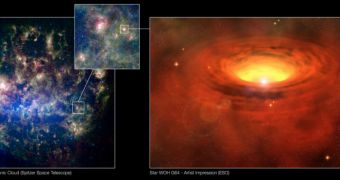With the help of the Very Large Telescope on top of the Paranal mountain, European Organization for Astronomical Research in the Southern Hemisphere astronomers have solved possibly one of the biggest mysteries related to the existence of the WOH G64 star, located in the near Large Magellanic Cloud galaxy. It appears that the estimates regarding the star's mass have been greatly overestimated, the new observations showing that the star is at least two times lighter than previously thought.
WOH G64 is a red supergiant star with a mass about 20 times that of the Sun, concentrated in a volume about 2,000 times greater than that of the Sun, found some 163,000 light years away from Earth.
"Previous estimates gave an initial mass of 40 times the mass of the Sun to WOH G64. But this was a real problem as it was way too cold, compared to what theoretical models predict for such a massive star. Its existence couldn't be explained", says Keiichi Ohnaka.
Also, previous models described the star as being surrounded by a spherical cloud of gas and dust, as opposed to the latest observations of the VLT which suggest that the star is actually surrounded by a toroidal-like cloud of dust and gas, which basically means that the star's luminosity and mass have been overestimated. According to calculations, the star must have started its life with a mass of approximately 25 solar masses, which would definitely fall within the currently observed temperatures.
"Still, the characteristics of the star mean that it may be experiencing a very unstable phase accompanied by heavy mass loss. We estimate that the belt of gas and dust that surrounds it contains between 3 and 9 solar masses, which means that the star has already lost between one tenth and a third of its initial mass", says Markus Wittkowski of the ESO, who co-authored the study.
The toroidal cloud of material surrounding WOH G64 spans from about 120 to 30,000 astronomical units into space, or 15 to 250 stellar radii.
"Everything is huge about this system. The star itself is so big that it would fill almost all the space between the Sun and the orbit of Saturn. And the torus that surrounds it is perhaps a light-year across! Still, because it is so far away, only the power of interferometry with the VLT could give us a glimpse on this object", says Ohnaka.

 14 DAY TRIAL //
14 DAY TRIAL //